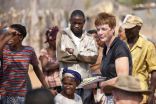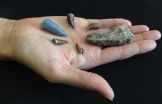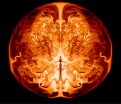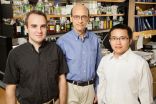(Press-News.org) What can DNA from the skeleton of a man who lived 2,330 years ago in the southernmost tip of Africa tell us about ourselves as humans? A great deal when his DNA profile is one of the 'earliest diverged' – oldest in genetic terms – found to-date in a region where modern humans are believed to have originated roughly 200,000 years ago.
The man's maternal DNA, or 'mitochondrial DNA', was sequenced to provide clues to early modern human prehistory and evolution. Mitochondrial DNA provided the first evidence that we all come from Africa, and helps us map a figurative genetic tree, all branches deriving from a common 'Mitochondrial Eve'.
When archaeologist Professor Andrew Smith from the University of Cape Town discovered the skeleton at St. Helena Bay in 2010, very close to the site where 117,000 year old human footprints had been found – dubbed "Eve's footprints" – he contacted Professor Vanessa Hayes, a world-renowned expert in African genomes.
At the time, Hayes was Professor of Genomic Medicine at the J. Craig Venter Institute in San Diego, California. She now heads the Laboratory for Human Comparative and Prostate Cancer Genomics at Sydney's Garvan Institute of Medical Research.
The complete 1.5 metre tall skeleton was examined by Professor Alan Morris, from the University of Cape Town. A biological anthropologist, Morris showed that the man was a 'marine forager'. A bony growth in his ear canal, known as 'surfer's ear', suggested that he spent some time diving for food in the cold coastal waters, while shells carbon-dated to the same period, and found near his grave, confirmed his seafood diet. Osteoarthritis and tooth wear placed him in his fifties.
Due to the acidity of the soil within the region, acquiring DNA from skeletons has proven problematic. The Hayes team therefore worked with the world's leading laboratory in ancient DNA research, namely that of paleogeneticist Professor Svante Pääbo at the Max Planck Institute for Evolutionary Anthropolgy in Leipzig, Germany, who successfully sequenced a Neanderthal.
The team generated a complete mitochondrial genome, using DNA extracted from a tooth and a rib. The findings provided genomic evidence that this man, from a lineage now presumed extinct, as well as other indigenous coastal dwellers like him, were the most closely related to 'Mitochondrial Eve'.
The study underlines the significance of southern African archaeological remains in defining human origins, and is published in the journal Genome Biology and Evolution, now online.
"We were thrilled that archaeologist Andrew Smith understood the importance of not touching the skeleton when he found it, and so did not contaminate its DNA with modern human DNA," said Professor Hayes.
"I approached Svante Pääbo because his lab is the best in the world at DNA extraction from ancient bones. This skeleton was very precious and we needed to make sure the sample was in safe hands."
"Alan Morris undertook some incredible detective work. He used his skills in forensics and murder cases to assemble a profile of the man behind the St Helena skeleton."
"Alan helped establish that this man was a marine hunter-gatherer - in contrast to the contemporary inland hunter-gatherers from the Kalahari dessert. We were very curious to know how this man related to them."
"We also know that this man pre-dates migration into the region, which took place around 2,000 years ago when pastoralists made their way down the coast from Angola, bringing herds of sheep. We could demonstrate that our marine hunter-gatherer carried a different maternal lineage to these early migrants – containing a DNA variant that we have never seen before."
"Because of this, the study gives a baseline against which historic herders at the Cape can now be compared."
While interested in African lineages, and how they interact with each other, Professor Hayes is especially keen for Africa to inform genomic research and medicine worldwide.
"One of the biggest issues at present is that no-one is assembling genomes from scratch – in other words, when someone is sequenced, their genome is not pieced together as is," she said.
"Instead, sections of the sequenced genome are mapped to a reference genome. Largely biased by European contribution, the current reference is poorly representative of indigenous peoples globally."
"If we want a good reference, we have to go back to our early human origins."
"None of us that walk on this planet now are pure anything - we are all mixtures. For example 1-4% of Eurasians even carry Neanderthal DNA"
"We need more genomes that don't have extensive admixture. In other words, we need to reduce the noise."
"In this study, I believe we may have found an individual from a lineage that broke off early in modern human evolution and remained geographically isolated. That would contribute significantly to refining the human reference genome."
INFORMATION:
Ancient human genome from southern Africa throws light on our origins
2014-09-29
ELSE PRESS RELEASES FROM THIS DATE:
DNA signature found in ice storm babies
2014-09-29
This news release is available in French. Montreal, September 29th, 2014 - The number of days an expectant mother was deprived of electricity during Quebec's Ice Storm (1998) predicts the epigenetic profile of her child, a new study finds.
Scientists from the Douglas Mental Health University Institute and McGill University have detected a distinctive 'signature' in the DNA of children born in the aftermath of the massive Quebec ice storm. Five months after the event, researchers recruited women who had been pregnant during the disaster and assessed their degrees of ...
Who are the men and boys suffering from anorexia?
2014-09-29
A new study by researchers from the University of Montreal reveals the current state of knowledge about anorexia in men and boys. "Most of the knowledge about anorexia pertains to females. However, about 10% of persons affected are males, and we believe this figure is underestimated," says Laurence Corbeil-Serre, lead author of the study. "Our results show that there appear to be similarities between the behavioural symptoms of males and females, but certain particularities can be identified in males, especially related to personality, gender identity, and sexual orientation."
The ...
Researchers show irradiation plus transplantation effective for treating HIV/AIDS
2014-09-29
Yerkes National Primate Research Center researchers are the first to show that an irradiation plus transplantation combination approach in nonhuman primates can be used to treat or even possibly cure HIV/AIDS, and this new model is providing some answers about the "Berlin patient," the only human thought cured of AIDS. The study is published in the September 25 issue of PLOS Pathogens.
Guido Silvestri, MD, division chief of Microbiology and Immunology at the Yerkes Research Center at Emory, and several of his research colleagues performed the first hematopoietic stem ...
Tooth buried in bone shows prehistoric predators tangled across land, sea
2014-09-29
About 210 million years ago when the supercontinent of Pangea was starting to break up and dog-sized dinosaurs were hiding from nearly everything, entirely different kinds of reptiles called phytosaurs and rauisuchids were at the top of the food chain.
It was widely believed the two top predators didn't interact much as the former was king of the water, and the latter ruled the land. But those ideas are changing, thanks largely to the contents of a single bone.
In a paper published online in September in the German journal Naturwissenschaften, Stephanie Drumheller of ...
Simulations reveal an unusual death for ancient stars
2014-09-29
Certain primordial stars—those 55,000 and 56,000 times the mass of our Sun, or solar masses—may have died unusually. In death, these objects—among the Universe's first-generation of stars—would have exploded as supernovae and burned completely, leaving no remnant black hole behind.
Astrophysicists at the University of California, Santa Cruz (UCSC) and the University of Minnesota came to this conclusion after running a number of supercomputer simulations at the Department of Energy's (DOE's) National Energy Research Scientific Computing Center (NERSC) and Minnesota Supercomputing ...
Myriad presents tumor BRACAnalysis CDx study at ESMO
2014-09-29
SALT LAKE CITY, Utah, Sept. 29, 2014 – Myriad Genetics, Inc. (Nasdaq: MYGN) today announced that its Tumor BRACAnalysis CDx™ companion diagnostic test significantly improved the detection of cancer-causing BRCA1/2 mutations by 44 percent in women with ovarian cancer. Data from this new study were presented at the 2014 European Society for Medical Oncology (ESMO) annual meeting in Madrid, Spain.
"Several previous clinical studies have demonstrated that patients with germline or somatic BRCA1/2 mutations respond to certain DNA-damaging medicines such as the platinum ...
Cells from placentas safe for patients with multiple sclerosis
2014-09-29
Patients with Multiple Sclerosis (MS) were able to safely tolerate treatment with cells cultured from human placental tissue, according to a study published today in the journal Multiple Sclerosis and Related Disorders. The study, which is the first of its kind, was conducted by researchers at Mount Sinai, Celgene Cellular Therapeutics subsidiary of Celgene Corporation and collaborators at several other institutions.
While designed to determine safety of the treatment, early signals in the data also suggested that a preparation of cultured cells called PDA-001 may repair ...
Greenland Ice Sheet more vulnerable to climate change than previously thought
2014-09-29
A new model developed by researchers at the University of Cambridge has shown that despite its apparent stability, the massive ice sheet covering most of Greenland is more sensitive to climate change than earlier estimates have suggested, which would accelerate the rising sea levels that threaten coastal communities worldwide.
In addition to assessing the impact of the increasing levels of meltwater created and spilled into the ocean each year as the climate continues to warm, the new model also takes into account the role that the soft, spongy ground beneath the ice ...
Scientists discover a new role for estrogen in the pathology of breast cancer
2014-09-29
CHAMPAIGN, Ill. — Scientists have discovered a previously unknown mechanism by which estrogen prepares cells to divide, grow and, in the case of estrogen-positive breast cancers, resist cancer drugs. The researchers say the work reveals new targets for breast cancer therapy and will help doctors predict which patients need the most aggressive treatment.
The University of Illinois team reports its findings in the journal Oncogene.
Estrogen pre-activates the unfolded-protein response (UPR), a pathway that normally protects cells from stress, the researchers report. The ...
Climate change appears a mixed bag for a common frog
2014-09-29
Scientists have found amphibians worldwide are breeding earlier due to climate change, but how that affects species is just now being answered.
After warmer winters, wood frogs breed earlier and produce fewer eggs, a Case Western Reserve University researcher has found.
Michael F. Benard, the George B. Mayer Chair in Urban and Environmental Studies and assistant professor of biology, also found that frogs produce more eggs during winters with more rain and snow.
Benard's study, published today in the journal Global Change Biology, is among the first in a natural habitat ...






